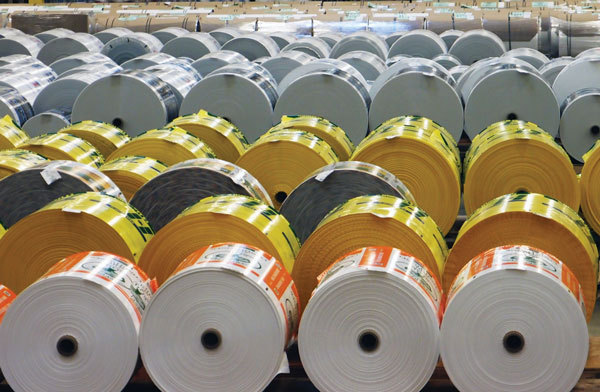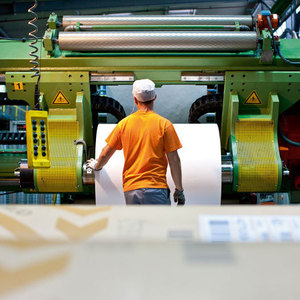More Than Just Price










PHOTO: MONDI GROUP
October 1, 2018
BY Ron Kotrba
For wood pellet manufacturers who bag their product for resale, the packaging is an important interface between their product, retailers and consumers. As important as this is, the bag is also a vital part of the distribution infrastructure and quality control.
“To me, it is part of the overall quality of my product,” says Don Wagner, general manager of Appalachian Wood Pellets Inc. “I see the relationship I have with my packaging supplier as one of the most important relationships I have. The bags are the delivery vehicle of my products. It’s what the consumer sees, so it must look good, but the No. 1 thing is, it must perform well—it must deliver the product to the stove intact.”
Appalachian Wood Pellets uses Trinity Packaging as its packaging supplier. “Their quality and service is why I use them,” he says. “I pick up the phone and call them, and the next day I have bags on my site. That’s what’s important to me. They’re part of my operation—a very important part. You get the best you can get, and stick with it.”
Wagner has been in the pellet business for 15 years. Before that, he was in sales. “I’ve been a salesman my entire career,” Wagner says, “and one of my biggest frustrations is salesmen from other companies who think price is the only issue. It’s a commodity business. Most people approach it from a price perspective—‘If I can save them a penny a bag, I can get their business.’ One of the most annoying parts of my job is there are hundreds of film companies that think all they need to do is walk through my door or get me on the phone and promise me a lower price.”
Appalachian Wood Pellets uses 2.5 million bags a year, so a penny per bag adds up. “But that’s not the most important thing to me,” Wagner says. “What is most important to me are quality and service. Yes, it has to be priced correctly, but in the plastic film industry, it’s a commodity, so they all pay the same amount for resin by weight. If someone wants to come in and offer a price 25 percent less, I will not even consider it. The only way they can do that is by cheating. I get 2.75 mil (thickness) bags from Trinity. If get a 1.75 mil bag, the consumer’s fingers go right through it. So my No. 1 thing is quality. I’ve dealt with other suppliers, if someone undercuts the price by a large amount, then it’s because they’re cheating. We’ve tested other bags and that’s what we’ve always found. We have found our vendor with good, consistently high-quality bags. That’s way more important to me than a penny a bag.”
Vendor Perspective
Trinity Packaging, along with PolyPak Packaging, did not respond to requests to participate in this article. Novolex’s Shields, TNT Plastics and Midwestern Bag declined speaking with Pellet Mill Magazine, and Primary Packaging was unable to interview before deadline. SPR Packaging, owned by Spain’s Armando Alvarez Group, and Europe-based firm Mondi Group, however, did agree to share their perspectives on wood pellet packaging.
SPR Packaging was founded in 2006 and completed its 180,000-square-foot manufacturing facility in North Texas in 2008. “It was a greenfield manufacturing site built for the manufacturing of flexible packaging,” says Trevor Wells, product manager with SPR Packaging. “All the equipment is brand new and state of the art.” In 2014, SPR Packaging was acquired by the Armando Alvarez Group, a diverse European company that owns 15 manufacturing centers, including its own biomass power plant. Since the acquisition, capital investments have been injected into the relatively new North Texas flexible packaging manufacturing facility for upgrades and product improvements. Wells says SPR Packaging first dove into the wood pellet market in 2010, and now serves some of the largest pellet manufacturers and distributors in the U.S.
“Principally, we are a vertically integrated manufacturer,” Wells says. “We extrude all of our polyethylene films on-site, make printing plates, and print up to 10 colors. We can send rollstock, or convert a variety of open-mouth, premade bags.” Wells says it is SPR Packaging’s services that set it apart from other plastic providers. “The technologies we employ here and our capabilities are different than other manufacturers in the U.S.,” he says. “We also consult with customers on how to improve packaging and sizing. We run tests to be the most cost-efficient while also making the bags more attractive and effective. We have sales representatives visiting different plants to help with their processes. On the other side, we can consult and design bags. And we can cut costs if need be.”
Being in the weather, and stacking pellet bags—moving them from place to place—can make for an abrasive journey, which can rub off ink and make bags less attractive at the retail level. Wells says to accommodate the harsh environments, bag designs and prints are getting more complex. “We are able to add our GPT energy-cured varnish, which adds gloss and provides ink protection,” he says. “This gives a special aspect to the bags. It makes them glossier, shinier—giving them a more premium look. Matte finishes are also available. That’s important, especially with barbecue pellets, which are more retail-oriented for higher-end brackets.” Since the bags may sit in outdoor environments for long stretches, SPR Packaging uses an ultraviolet inhibitor, which helps prevent degradation from sunlight, as well as specific inks designed for outdoor environments to provide fade resistance.
Sustainability
Wells says one of the biggest changes in pellet packaging has been downgauging, or moving from thicker to thinner films without sacrificing quality. “When we entered the market, thicker films were more common,” he says. “But now, with the way the market has gone, big distributors like Wal-Mart are encouraging suppliers to use less materials in packaging. That’s a major impetus for change.” The less polyethylene used in manufacturing, the less material enters waste or recycling streams.
Thinner material doesn’t necessarily mean a weaker bag, Wells says, given the advent of newer, stronger resins and manufacturing techniques. “Here at SPR Packaging, our co-extrusion process produces a multilayer structure with three to five layers, which means we can create a thinner, stronger bag,” Wells says. “Plus, it cuts costs on a per-bag basis.”
In 2014, Mondi Group, an international packaging and paper company with 100 production sites in 30 countries, developed the concept for natural packaging for wood pellets. Mondi Group is based in Europe, where single-use plastics are under increased scrutiny. “In Europe, there’s a huge discussion on recyclability,” says Verena Schnedl, marketing manager for Mondi’s extrusion coatings segment. Out of this discussion, and through forecasting future consumer demand, came the company’s Skog natural packaging. “Skog” is the Swedish word for “forest.” Schnedl says, “The idea was to find a packaging solution for pellets that also comes out of wood.”
Mondi Group’s Skog packaging is paper-based with an extrusion coating made of biopolymers. Schnedl says using a biopolymer coating to line its paper packaging simply makes sense from a marketing perspective. “Extrusion coating is a technology we use to combine different substrates, to create functionality,” she says. While the Skog packaging is entirely renewable, Schnedl points out that it is not biodegradable. “We want customers to be able to store it without breaking down,” she explains. “Making pellet bags biodegradable is a decision that would not make sense.”
Being a new and different product, Skog packaging is slowly being accepted by pellet producers. “There are believers and nonbelievers,” Schnedl says. “It’s different. What we see is people are skeptical. They like it, but they are skeptical.” One major aspect pellet producers are doubtful of is whether the material can run in their existing form-fill-seal (FFS) bagging machines. “To overcome this skepticism, seeing is believing,” Schnedl says. “We provide potential customers a test reel to try on their machine. Once we prove to them it can run on their existing machines without investment, they are more accepting.” She says only minor amendments to their equipment, such as adjusting the sealing temperature, must be done. Skog packaging, however, cannot use a window in the bag necessary to see the product, as some countries may require. “You cannot do this with paper,” Schnedl says.
An unanticipated benefit of Skog packaging is its stackability. “It has to do with friction,” Schnedl says, “and the ability of paper to form better. It was unexpected for us. But when we saw the bags on a pallet, they were more stable and didn’t move that much. It makes the whole pallet more stable.”
Schnedl says the product, made in Sweden, has been thoroughly tested. “Sweden gives really good conditions to test in winter,” she says. “We have a good product, and we believe this whole plastic discussion will pick up in other countries.”
Price-wise, Skog packaging compares more to thicker plastic films. “For us, this is not a product that will get market share because we are cheaper,” she says. “It’s more of a mentality product, so to speak. If you believe in paper, then this packaging is a natural product compared to one made from crude oil. What we see is our customers who use Skog packaging see a benefit for their brand. Customers normally use it for their premium brands, as it doesn’t make as much sense for their lower-quality product.”
Wells says SPR Packaging is on the forefront of sustainability issues in the U.S. “Our headquarters are in Europe, where these initiatives have taken hold,” he says. “We have experience in these markets for recycled materials and biopolymers. Here in the U.S., we are not using recycled materials in our pellet film. Recycled material of acceptable quality can be difficult to source and is more costly than prime, virgin resin.” Wells says if consumers demand plastics made from renewable or recycled materials, SPR Packaging can accommodate their requests. “The challenge is the cost,” he says.
Advertisement
Advertisement
“I have a lot of experience with bioresins,” Wagner says. “They have great applications, but I’m not sure this is one of them. Bioresins allow the material to decompose. We are on the opposite end. Our bags have UV inhibitors so the sun doesn’t break down the bags. Most inventory at the retail level is stored outside in the sun. Biopolymers would break down quickly in that environment.”
Out of the hundreds of thousands of tons Appalachian Wood Pellets has sold, Wagner says he may have gotten two phone calls over the years asking about whether his wood pellet bags are made of renewable or recycled materials. “The bags are recyclable,” he says, “so we do encourage that. And we recycle everything here at the plant.” Wagner adds that while his current bags do not display the chasing arrows symbol to indicate the bags’ recyclability, he plans to add it the next time changes are made to the print design. “We don’t change artwork often,” he says. “If you have a brand, you run it for years. But the next time we do plate changes, we will put the recycle logo on the bags.”
Wells says SPR Packaging’s focus is helping tell the complete story for pellet manufacturers about renewable energy. “We’re on the same team as pellet manufacturers,” he says. “We’re trying to help them grow, so we’ll do whatever possible to do so. Our side is packaging, and we continue to take environmental initiatives to make packaging less impactful in a negative way.” In addition to downgauging, SPR Packaging has other, confidential projects in the works, according to Wells. “Pellets are renewable energy, and we want to tell the same story pellet makers are telling. We are always pushing ourselves to be better on the packaging side.”
Fighting Chance
When asked what advice he can offer customers to extend the shelf life of their bagged pellet products and the packaging that protects and transports their pellets, Wells says rotation is critical. “First in, first out,” he says. “That goes for the bags before the pellets are packaged, and the filled bags at the plant and in the retailer’s yard.” Wells adds that he always recommends the bags be covered. “Use shrink hooders and stretch wrap, or pallet caps—anything to add an extra layer of protection to keep the bags in good condition and protected from the elements,” he says.
Appalachian Wood Pellets uses a robot to stack 50 40-pound bags onto a pallet, and then a Lachenmeier machine applies a 4.25-mil stretch hooder over the bags for weather protection. “Some use stretch wrap, but that can come off and get moisture between the bags and wrapping, which attracts dust and dirt, and looks bad at retail,” Wagner says. “The stretch hooder, which we also buy from Trinity, gives the ultimate weather protection. It goes back to quality. For the retailer who’ll store these outside, it provides the best protection they can get to preserve the product so when the end-consumer gets it, it’s in the same condition as when it left the plant.”
Pellet bags are designed to be in the elements. “But give them a fighting chance,” Wells says. “You just don’t know how long the retailer will keep them in their yard. So we recommend taking all the precautions you can.”
Author: Ron Kotrba
Senior Editor, Pellet Mill Magazine
218-745-8347
rkotrba@bbiinternational.com
Advertisement
Advertisement
Upcoming Events





